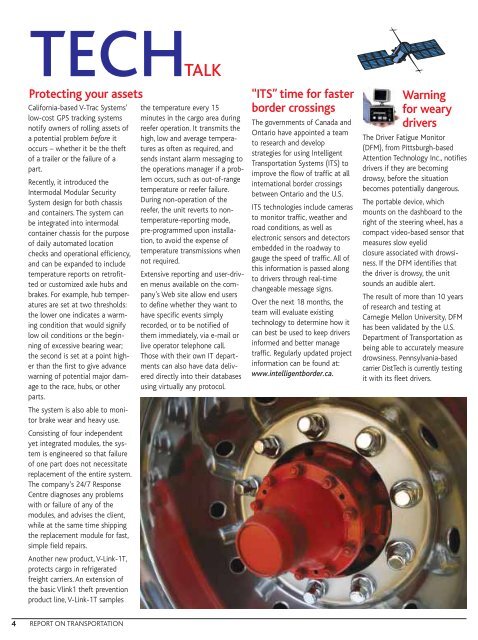TECHTALKProtecting your assetsCalifornia-based V-Trac Systems’low-cost GPS tracking systemsnotify owners of rolling assets ofa potential problem before itoccurs – whether it be the theftof a trailer or the failure of apart.Recently, it introduced theIntermodal Modular SecuritySystem design for both chassisand containers. The system canbe integrated into intermodalcontainer chassis for the purposeof daily automated locationchecks and operational efficiency,and can be expanded to includetemperature reports on retrofittedor customized axle hubs andbrakes. For example, hub temperaturesare set at two thresholds:the lower one indicates a warmingcondition that would signifylow oil conditions or the beginningof excessive bearing wear;the second is set at a point higherthan the first to give advancewarning of potential major damageto the race, hubs, or otherparts.The system is also able to monitorbrake wear and heavy use.Consisting of four independentyet integrated modules, the systemis engineered so that failureof one part does not necessitatereplacement of the entire system.The company’s 24/7 ResponseCentre diagnoses any problemswith or failure of any of themodules, and advises the client,while at the same time shippingthe replacement module for fast,simple field repairs.Another new product, V-Link-1T,protects cargo in refrigeratedfreight carriers. An extension ofthe basic Vlink1 theft preventionproduct line, V-Link-1T samplesthe temperature every 15minutes in the cargo area duringreefer operation. It transmits thehigh, low and average temperaturesas often as required, andsends instant alarm messaging tothe operations manager if a problemoccurs, such as out-of-rangetemperature or reefer failure.During non-operation of thereefer, the unit reverts to nontemperature-reportingmode,pre-programmed upon installation,to avoid the expense oftemperature transmissions whennot required.Extensive reporting and user-drivenmenus available on the company’sWeb site allow end usersto define whether they want tohave specific events simplyrecorded, or to be notified ofthem immediately, via e-mail orlive operator telephone call.Those with their own IT departmentscan also have data delivereddirectly into their databasesusing virtually any protocol.“ITS” time for fasterborder crossingsThe governments of Canada andOntario have appointed a teamto research and developstrategies for using IntelligentTransportation Systems (ITS) toimprove the flow of traffic at allinternational border crossingsbetween Ontario and the U.S.ITS technologies include camerasto monitor traffic, weather androad conditions, as well aselectronic sensors and detectorsembedded in the roadway togauge the speed of traffic. All ofthis information is passed alongto drivers through real-timechangeable message signs.Over the next 18 months, theteam will evaluate existingtechnology to determine how itcan best be used to keep driversinformed and better managetraffic. Regularly updated projectinformation can be found at:www.intelligentborder.ca.Warningfor wearydriversThe Driver Fatigue Monitor(DFM), from Pittsburgh-basedAttention Technology Inc., notifiesdrivers if they are becomingdrowsy, before the situationbecomes potentially dangerous.The portable device, whichmounts on the dashboard to theright of the steering wheel, has acompact video-based sensor thatmeasures slow eyelidclosure associated with drowsiness.If the DFM identifies thatthe driver is drowsy, the unitsounds an audible alert.The result of more than 10 yearsof research and testing atCarnegie Mellon University, DFMhas been validated by the U.S.Department of Transportation asbeing able to accurately measuredrowsiness. Pennsylvania-basedcarrier DistTech is currently testingit with its fleet drivers.4 REPORT ON TRANSPORTATION
PITCHING INTrotting out a cure for breast cancerFor the third year running, the<strong>Trailcon</strong> Trotters – 13 <strong>Trailcon</strong>Leasing employees, family members,and friends – laced up theirsneakers to take part in the CIBCRun for the Cure to raise moneyfor the Canadian Breast CancerFoundation. This year, theTrotters raised more than$12,000, surpassing their 2003total of over $10,000.The team was especially thrilledby the participation of AnitaLombardi, the wife of one of ourmobile mechanics, NickLombardi. A breast-cancer survivor,Anita was the inspirationfor the <strong>Trailcon</strong> Trotters when theteam formed in 2002.<strong>Trailcon</strong> thanks all our employees,mechanics, customers, suppliers,friends, and family who donatedmoney to this worthwhile cause.The 170,000 Canadians who participated,donated, or volunteeredhelped raise $19.2 million forbreast cancer research andawareness programs, comparedwith about $17 million last year.Back row, from l to r: Donna Payne, Matt Watters, Pamela O’Brien, Trish Brisson, Anita Lombardi, Nick Lombardi.Front row: Sally Lamonte, Cathy Gardiner, Jim Wedgewood, Kim Nadas.Missing from photo: David Carter, Joan Nessman, Linda O’Brien.A little goes a long wayThe following letter was received by <strong>Trailcon</strong> Leasing.Many thanks to <strong>Trailcon</strong> Leasingfor their generous gift of $400 tothe summer camp program!Your donation to a Caledon childbrought light to an otherwisecloudy summer. Your gift broughtopportunities to feel the breeze,to see the trees and understandlife from a brand new perspective.This letter brings news of betterdays for 47 children who mightnot have gone to camp. Thankyou for seeing that this is a causefor all of us, an investment in thefuture and strength for thecommunity: our children. Somefeedback Caledon CommunityServices received:“I finally learned to swim.”“My kids had the opportunityto be carefree for one weekthis year.”“Thank you so much. The costof camp is beyond our reach.”Because of you, a child’spossibilities are endless! Again,many heartfelt thanks!Yours very truly,Debbie Malevris,Director of Resources,Caledon Community ServicesP.S. For more informationregarding our services, pleasevisit our Web site at:www.caledoncommunityservices.orgHbc Rewards communitiesHudson’s Bay Company hascreated what it calls thelargest community-basedfundraising program in thecountry with theintroduction of itsHbc RewardsCommunityProgram. The Program allowscommunity and charity groupsto register with Hbc so thattheir supporting members candonate Hbc Rewards pointsdirectly to help their community.Hbc customers can visit anyof the more than 500 Bay,Zellers, and Home Outfittersstores, or go online towww.hbcrewards.com/community,and simply link theirHbc Rewards card to thecommunity group to whichthey wish to donate theirpoints. Customers can allocatethe percentage of points theywish to donate. Communitygroups receiving the donationscan use the points to selectmerchandise or gift cards touse in support of fundraisingactivities for their community.Groups whosign up for theHbc RewardsCommunityProgram will receive up to80,000 bonus Hbc Rewardspoints to kick-start theiraccount.“For anyone who has everwanted to help their locallittle league team, school,hospital, shelter, or othercommunity group, the HbcRewards Community Programwill make it easier than ever,”says George Heller, Presidentand CEO, Hudson’s Bay Co.“We’re proud to offer thiscommunity-based initiativeacross Canada, in addition todonating over $11 millioneach year to charities acrossCanada.”Masonite raises funds to fight cancer<strong>Trailcon</strong> customer Masonite International swung into fundraisingin a big way with its 5th Annual Masonite Charity Golf Classic.Employees, customers, suppliers, and friends raised $130,000 insupport of the PhilipS. Orsino Facility forCell Therapy andHematology Centre.The Centre, namedafter MasonitePresident and CEOPhilip Orsino, performsspecializedtypes of bone marrowtransplants forleukemia and othercancer patients atPrincess MargaretHospital in Toronto.From l to r: Participants Deryck Kahn, Director of Inventory and Logistics, Masonite International;Peter Collins, Sales and Marketing Manager, <strong>Trailcon</strong> Leasing; Cathy Gardiner, Controller, <strong>Trailcon</strong>Leasing; and Paul Bernards, Executive Vice President and CFO, Masonite International.FALL <strong>2004</strong> - VOLUME NO. 315






